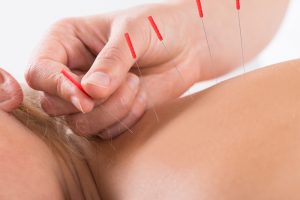 You have seen it in movies and commercials, and some think it looks painful. Even if you have never tried acupuncture before, you know there are many benefits. If one thing is for sure, you’ve probably wondered at some point, “What is acupuncture?”
You have seen it in movies and commercials, and some think it looks painful. Even if you have never tried acupuncture before, you know there are many benefits. If one thing is for sure, you’ve probably wondered at some point, “What is acupuncture?”
Acupuncture stems from traditional Chinese medicine. Acupuncture as a practice dates back to the Han Dynasty of 100 BC, according to records, but was likely utilized before then. Today’s practice evolved past its ancient origins and modernized significantly.
Acupuncture is a unique system of techniques that treats its patients by stimulating points in the body, often with very thin needles, and helps encourage the body to heal naturally. Ancient acupuncture philosophy states when the flow of energy—called “qi (pronounced chee)—is blocked or hindered, pain and illness occur.
Acupuncture has shown to be a proven treatment option for pain and certain illnesses. The World Health Organization recognizes a list of diseases, symptoms and conditions which acupuncture is an effective treatment based on controlled trials. Here’s a list of some of the more common and known diseases listed:
- Low-back pain
- Neck pain
- Osteoarthritis/Knee Pain
- Headache
So how does acupuncture work?
Most acupuncture points are located on or near the surface of the skin. The acupuncturist will insert a very fine needle 1/4 of an inch to an inch deep into these acupuncture points. Needless acupuncture and electrical stimulation are used on children to avoid puncturing their skin.
Ancient acupuncturists were on to something with “qi.” One hypothesis states when the needles stimulate the nerves, sending signals to the brain that release mood-boosting chemicals into throughout the body. The body is electric by the way cells communicate with each other. Endorphins are the body’s natural pain-killing chemicals and affect the areas of the brain controlling serotonin. These pain-killing chemicals actually block the pain messages, with other regulatory effects as well, like improving mood.
An acupuncturist will adjust the needles and apply heat, electrical stimulation, or herbs, throughout the 10 to 30-minute session. The adjustments help target the acupuncture points and nerves in different ways and at angles.
Does acupuncture it hurt?
The needles are much thinner than injection or sewing needles, but you will still feel a slight prick. Afterward, you may experience some bruising and soreness, but this will subside shortly as acupuncture is one of the safer treatment options available. One major benefit of acupuncture is the only side effect is soreness, whereas drugs can carry a list of adverse side effects. In addition, the chance of infection from the needles is eliminated due to regulatory guidelines that require acupuncturist to only use new, sterile needles—just like doctors.
What should I do after an acupuncture treatment?
Bring a friend to drive you home after the first session, as acupuncture tends to have a calming effect. Gauge your feelings after and decide if a friend is necessary for the next sessions. The number of sessions needed depends on a patient’s condition, but one session is not enough. Generally speaking, most treatments plans are around 10 sessions for three months.
If you would like additional information on acupuncture, call Fletcher Chiropractic, or reach out to us online.
